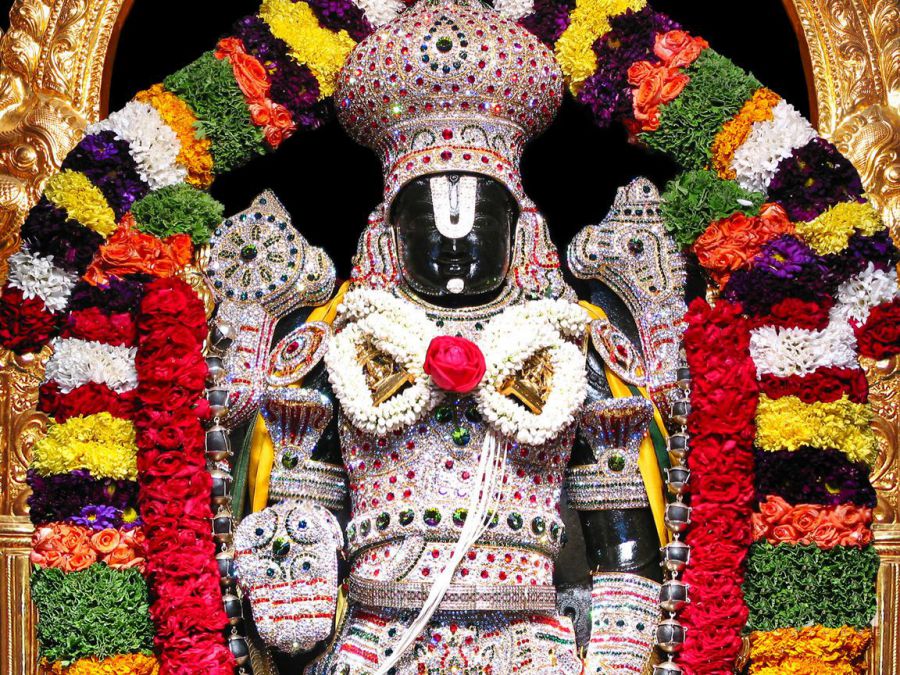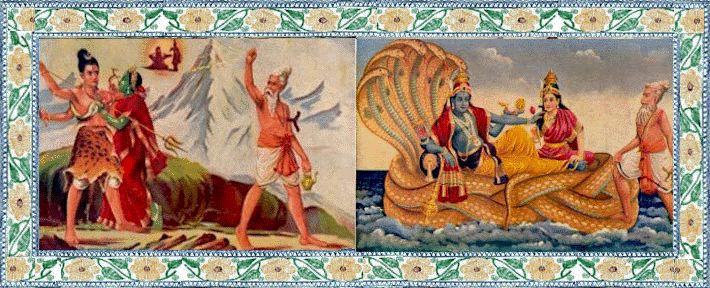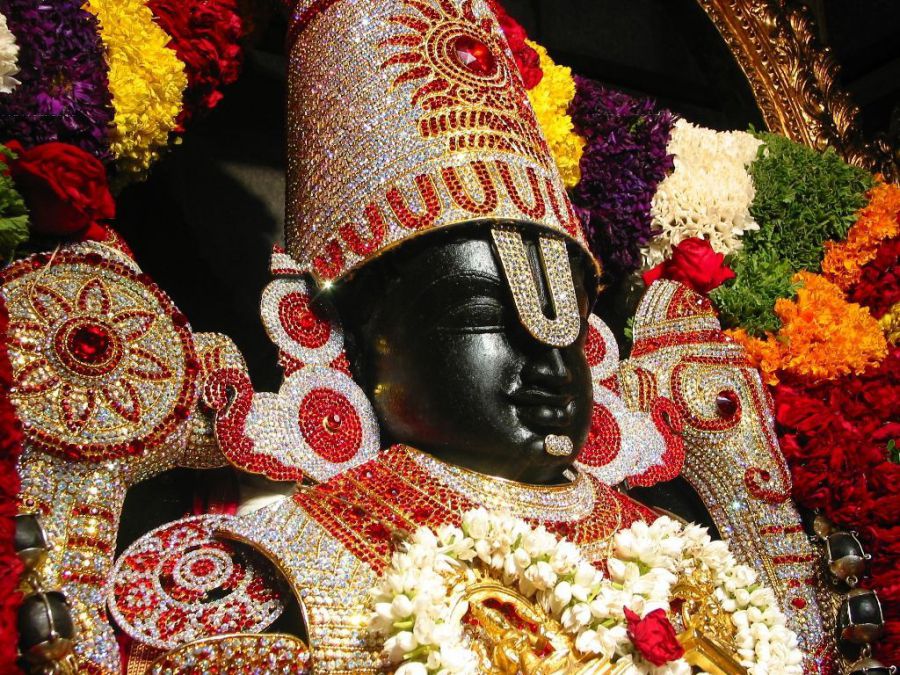No products in the cart.
According to the Hindu scriptures, Vishnu, out of love towards his devotees, incarnated as Venkateswara and appeared for the salvation and upliftment of humanity in this Kali Yuga age. It is considered the supreme form of Vishnu in this age. The Venkateswara swami temple is also called Kaliyuga Vaikuntam. Venkateswara is another form of Lord Vishnu who is the most popular deity in South India. He is also known as Venkatachalapathi or Venkataramana or Tirumal devar or Varadaraja or Srinivasa or Balaji or Bithala. He has a dark complexion and four hands. In his two upper hands he holds a discus (a symbol of power) and a conch’s hell (a symbol of existence). With his lower hands extended downward he asks devotees to have faith and surrender to him for protection. The supreme temple of Venkateswara is at Tirupati and every Vishnu Devotee wants to visit this temple at least once in life.
Once some rishis headed by Kashyapa began to perform a sacrifice on the banks of the Ganges. Sage Narada visited them and asked them why they were performing the sacrifice and who would be pleased by it. Not being able to answer the question, the rishis approached Sage Bhrigu. To reach a solution after a direct ascertainment of reality, Sage Bhrigu first went to Satyaloka, the abode of Lord Brahma. At Satyaloka, he found Lord Brahma, reciting the four Vedas in praise of Lord Narayana, with each of his four heads, and attended upon by Saraswati. Lord Brahma did not take notice of Bhrigu offering obeisance. Concluding that Lord Brahma was unfit for worship, Bhrigu left Satyaloka for Kailasa, the abode of Lord Shiva. At Kailasa, Bhrigu found Lord Siva spending his time pleasantly with Parvati and not noticing his presence. Parvati drew the attention of Siva to the presence of the sage. Lord Siva was furious at Bhrigus intrusion and tried to destroy him. The sage cursed Lord Siva and left for Vaikuntha. At Vaikuntha, Lord Vishnu was reposing on Adisesha with Sri Mahalakshmi in service at His feet. Finding that Lord Vishnu also did not notice him, the sage was infuriated and kicked the Lord on His chest, the place where Mahalakshmi resides. At once, Lord Vishnu hastened to apologize to the angry sage and pressed his feet to allay the pain caused to Bhrigus leg. In doing so the Lord removed the eye in the foot of the sage, stripping of his special powers. Thereupon, the sage concluded that Lord Vishnu was the most supreme of the Trimurthis and told the rishis the same.
Lord Vishnu as Venkateswara
Sri Mahalakshmi was angered by the action of her Lord in apologizing to Bhrigu who committed an offence. Out of anger and anguish she left Vaikuntha and resided in Karavirapur now known as Kolhapur. After the departure of Mahalakshmi, a forlorn Lord Vishnu left Vaikuntha and took abode in an ant-hill under a tamarind tree, beside a Pushkarini on the Venkata Hill, meditating for the return of Lakshmi, without food or sleep. This was the place where Lord took the form of Varaha to rescue Mother Earth form the deep ocean. Taking pity on Lord Vishnu, Brahma and Maheshwara decided to assume the forms of a cow and its calf to serve Him. Surya, the Sun God informed Mahalakshmi of this and requested her to assume the form of a cowherds and sell the cow and calf to the king of the Chola country. The king of the Chola country bought the cow and its calf and sent them to graze on the Venkata Hill along with his herd of cattle. Discovering Lord Vishnu on the ant-hill, the cow provided its milk, and thus fed the Lord. Meanwhile, at the palace, the cow was not yielding any milk, for which the Chola Queen chastised the cowherd severely. To find out the cause of lack of milk, the cowherd followed the cow, hid himself behind a bush and discovered the cow emptying her udder over the ant-hill. Incensed over the conduct of the cow, the cowherd aimed a blow with his axe on the head of the cow. However, Lord Vishnu rose from the ant-hill to receive the blow and save the cow. When the cowherd saw the Lord bleed at the blow of his axe, he fell down and died of shock.
The cow returned, bellowing in fright and with blood stains all over her body, to the Chola King. To find out the cause of the cow’s terror, the King followed her to the scene of the incident. The King found the cowherd lying dead on the ground near the ant-hill. While he stood wondering how it had happened, Lord Vishnu rose from the ant-hill and cursed the King saying that he would become an Asura because of the fault of his servant. The King pleaded innocence, and the Lord blessed him by saying that he will be reborn as Akasa Raja and that the curse would end when the Lord will be adorned with a crown presented by Akasa Raja at the time of His marriage with Padmavati. With these words Lord turned into stone form. Thereafter, Lord Vishnu in the name of Srinivasa, decided to stay in Varaha Kshetra, and requested Sri Varahaswami to grant Him a site for His stay. His request being readily granted, Srinivasa ordained that a pilgrimage to His shrine would not be complete unless it is preceded by a bath in the Pushkarini and darshan of Sri Varahaswami, and that puja and Naivedyam should be offered to Sri Varaha swami first. Vishnu built a hermitage and lived there, attended to by Vakuladevi who looked after him like a mother.
Yasoda is Reborn as Vakuladevi
Yasoda brought up Sri Krishna, the son of Devaki, in his early years. However, Yasoda was not blessed to witness the marriage of Sri Krishna with Rukmini and she felt very sad. Sri Krishna promised to fulfil her desire in her next birth as Vakuladevi in his next incarnation as Srinivasa. In Rukmini’s next birth as Vakuladevi, she was serving Lord Varahaswami when He sent her to serve Srinivasa. Sometime later, a King named Akasa Raja who belonged to the lunar race was ruling over Thondamandalam. Akasa Raja had no heirs, and therefore, he wanted to perform a sacrifice. As part of the sacrifice, he was ploughing the fields when his plough turned up a lotus in the ground. On examining the lotus, the King found a female child in it. The king was happy to find a child even before he performed a sacrifice and carried it to his place and gave it to his Queen to tend it. At that time he heard an aerial voice which said “O King, tend it as your child and fortune will befall you”. As she was found in a lotus, the king named her Padmavati. Princess Padmavati grew up into a beautiful maiden and was attended by a host of maids.
The Holy Town of Tirumala:
The temple town of Tirupati is situated at the foot of Tirumala hills in the Chandragiri Taluka of the Chittor district in Andhra Pradesh. The sacred spot on the hill about 2,800 feet above sea level is known as Tirumala, the abode of Lord Venkateswara. The hill forms part of the Eastern Ghats and is also known as Venkatachala and Seshachala. It is said that the Eastern Ghats on this side along with their curves, heights and falls resemble the serpent Adisesha and that the seven hills of Tirupati are its seven heads and Ahobalam where Lord Narsimha murthy is worshiped, representing the centre of Adisesha, and Srisailam representing the tail end of Adisesha. That is why Tirumala is called Seshachala. According to the legends, this has been a sacred place in all the four yugas, and was known as Vrishabhachala in the Krithayuga, Anjanachala in the Tretayuga, Seshachala in the Dwaparyuga and Venkatachala in the present Kaliyuga. In this temple, unlike other Vishnu temples, we find no minor shrines or idols of Vaishnava saints. Apart from the Lord Venkateswara temple, the other important places at Tirumala and Swami Pushkarini, Papavinasam and Akasaganga waterfalls, Varahaswami temple, and Shila Toranam a very ancient rock formation supposed to be over 10,000 years old.








